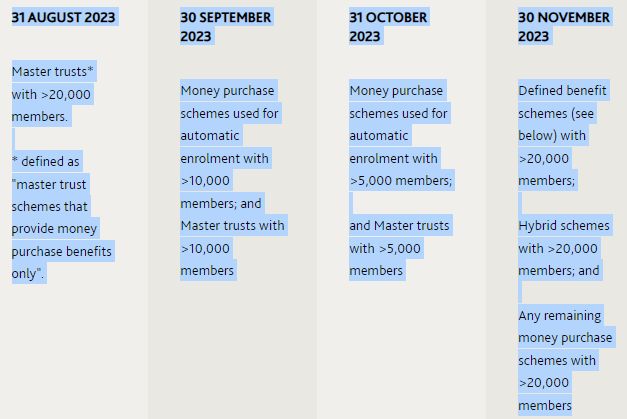Has your head stopped spinning yet? Not from Christmas excess or one too many New Year's Eve drinks, but from a remarkable and busy year in pensions. Pensions in 2022 was like a rollercoaster - fast moving, sharp turning, surprising and, at times, making you want to scream.
Will 2023 be a calmer and more predictable year in pensions? Possibly, although we are operating in a world where it is wise to try to anticipate the unexpected. There is still plenty to keep the pensions industry busy. With so many consultations, legislative changes and updated pieces of guidance, it can be difficult to keep up. There is also a sense of déjà vu with this year's list, with many developments pushed into 2023 from 2022.
To make sense of this year in pensions, this insight highlights seven key developments that will dominate the industry in 2023.
Key themes for pensions in 2023
- Finalising the new DB scheme funding regime
- Extending TPR's notifiable event regime to cover certain corporate activities
- TPR's single code of practice comes into force
- Risk transfer – Set to break more records?
- Pensions dashboards go live
- Fall-out from the LDI liquidity crunch
- Climate risk reporting in practice
- Other developments to watch out for in 2023
1. Finalising the new DB scheme funding regime
The Pension Schemes Act 2021 provides the statutory footing for a new scheme funding regime for defined benefit (DB) schemes. Completing the picture in 2023 will be the final versions of:
- secondary legislation (expected to be called the Occupational Pension Schemes (Funding and Investment Strategy and Amendment) Regulations 2023) (the Funding and Investment Strategy Regulations); and
- regulatory guidance (The Pension Regulator's (TPR) DB funding code of practice) (the New Scheme Funding Code).
Drafts of both of these were published for consultation in 2022 (on 26 July 2022 for the Funding and Investment Strategy Regulations and 6 December 2022 for the second consultation on the New Scheme Funding Code).
Under the new scheme funding regime, trustees of DB schemes will have to:
- have a scheme-specific funding and investment strategy (also referred to as a 'long-term objective');
- produce a written statement setting out their strategy;
- appoint a Chair (if one is not already in place); and
- submit a version of the statement of strategy signed by the chair of trustees to TPR.
A consultation on the draft regulations closed on 17 October 2022 and the consultation on the draft New Scheme Funding Code closes on 24 March 2023. The new regime requires schemes to aim for a 'low dependency' model once they have reached 'significant maturity'. It also focuses on identifying the period over which trustees have reasonable confidence in the ability of the sponsor to fund the scheme.
Final versions of the Funding and Investment Strategy Regulations and the New Scheme Funding Code should be available by the summer and they are currently planned to come into force in October 2023. The new regime will apply to valuations with an effective date on or after the date the Funding and Investment Strategy Regulations go into force.
Whilst this will be of greatest importance for schemes with effective dates for their valuations in Q4 2023, it will be important for all trustees and sponsors to get to grips with the new regime. TPR encourages engagement between trustees and sponsors, and both should engage their professional advisers as they consider how the new regime will impact future valuations.
2. Extending TPR's notifiable event regime to cover certain corporate activities
TPR's powers on notifiable events were extended under the Pensions Schemes Act 2021. Some of these changes went into force on 1 October 2021 (including the new increased penalties for failure to comply with the notifiable event requirements). A broader set of notifiable events were then expected to go into force on 6 April 2022. This date came and went.
The Department for Work and Pensions (DWP) has yet to publish its consultation response or lay the final regulations before Parliament although we do understand the intention remains to introduce them at some point in 2023.
Under the pending notifiable events regime, sponsoring employers will be required to notify TPR when a 'decision in principle' is made in relation to certain key corporate transactions. These include:
- sale of a material portion of the sponsor's business or assets;
- granting security over assets above a certain value; and
- certain corporate restructuring (e.g. changes in who controls the sponsoring employer).
There will be a new duty on employers to give notices and statements to TPR that set out:
- the implications for a DB scheme of certain corporate events; and
- how any risks to the scheme will be mitigated.
The notice and statement will be required at a later point in a corporate transaction than the notifiable event notification, when there is greater certainty as to whether the transaction is going ahead, its nature and the implications for the scheme.
Both employers and trustees will be keen to scrutinise the final regulations to understand precisely what will be required going forward. We anticipate that sponsors will increasingly want to position such notifiable events in context of the wider scheme funding journey discussed in section 1 above.
3. TPR's single code of practice comes into force
TPR currently has 15 codes of practice. The codes set out TPR's expectations of the conduct and practice trustees should meet in order to comply with their existing duties in pensions legislation, in particular, to operate using an 'effective system of governance'.
TPR's existing codes of practice are in the process of being turned into a single code of practice. TPR believes this will makes its code of practice clearer, more accessible and easier to update. Once complete, the single code of practice promises to provide an up to date and consistent source of information on scheme governance and management.
The draft single code (the Code) is divided into five sections:
- the governing body.
- funding and investment.
- administration.
- communication and disclosure.
- reporting to the Regulator.
Within these broad sections, there are subjects and sub-subjects. These make up the 51 modules that comprise the single code. An important new requirement will be the 'own risk assessment', which trustees will need to undertake in order to check that their system of governance is indeed effective in practice.
The final version of the single code was expected to be laid before Parliament and to go in to force in 2022. This did not happen. In November 2022, TPR expressed a hope that the single code would be laid before Parliament "towards the end of this year [2022] or the beginning of January [2023]". If this is done, it is likely that the single code will go into force in Q2 2023.
Once the final Code is published, trustees will want to assess with their advisers what the sensible and proportionate next steps are in order to comply. We think it will be helpful to look at the Code through the lens of a scheme's long-term strategy so that work on the Code is aligned to that.
4. Risk transfer – Set to break more records?
Pensions risk transfer has just had one of its busiest years. It is likely to be followed by an even busier year as market factors drive a surge in demand for pension risk settlement.
As well as an increasing number of transactions, industry commentators have highlighted the probable return of multi-billion pound 'mega-deals' as well as a potential shift from pensioner-only buy-ins to full scheme buy-outs. The insurance industry is flexing to meet these demands, with new sources of capacity (e.g. funded reinsurance).
With high demand and keen pricing, it is vital that trustees do as much preparation for transactions as possible. This will focus on having:
- high quality, clean and up to date data (something which is also vital for pensions dashboard – see section 5 below); and
- a clear picture of the benefits that are to be insured (there has been a noticeable increase in the amount of benefit specification work being commissioned by trustees and sponsors).
Trustees should also be thinking about their scheme's asset allocations so that they have the right assets in place when they need them to execute an insurance trade.
Finally, and importantly, trustees will need to discuss with sponsors what level of cover they will seek from the bulk insurer and how to approach coverage for residual risks that are not covered by it.
5. Pensions dashboards go live
This year will see the first staging dates for pensions dashboards. Staging dates are the date by which a pension scheme has a legal duty to connect to the pensions dashboards system. In an echo of automatic enrolment, pensions dashboards are being rolled out to the largest schemes first, including the largest Defined Contribution (DC) master trusts. The Pensions Dashboards Regulations 2022 are now in force and set out a schedule of staging dates. The key dates for 2023 are:

For defined benefit schemes, a key date will be 30 November 2023 when the very largest of such schemes have staging dates. This will apply to those schemes with more than 20,000 members. In the legislation, these schemes are described as "schemes without money purchase benefits, other than public service pension schemes or parliamentary pension schemes". Hybrid schemes are also included at this staging date. Various dates in 2024 will be the relevant staging dates for many more defined benefit schemes.
Membership for the purposes of calculating staging dates comprises active, deferred and pension credit members. It does not include pensioner members (i.e. those members who are entitled to the present payment of their pension benefits). This is assessed as on the scheme's year end date that fell between 1 April 2020 and 31 March 2021 (inclusive).
The messages from the DWP, TPR and the Pensions Dashboards Programme are clear. Trustees need to understand their legal duties in relation to pensions dashboards and put in place a framework for timely delivery by the legislative deadline. To help with this, trustees should consider:
- including pensions dashboards as a regular agenda item for trustee meetings;
- how they will ensure that they have the right people in place to make the necessary decisions – is this the responsibility of a sub-committee or a special project group?;
- what help they can get from their advisers and third party service providers and whether they will need to engage any other service providers; and
- the data protection aspects of the project.
We expect 2023 to be the year in which work starts in earnest on preparation for pension dashboards for many schemes. The priority for schemes needs to be data cleansing (i.e. ensuring that the data held is as accurate and complete and possible by the staging date). Data also needs to be held in the appropriate format. Trustees will need to decide what 'matching criteria' they will use in order to determine if a person requesting pensions information through the dashboard is one of the scheme's members.
6. Fall-out from the LDI liquidity crunch
In September 2022, the pensions industry grappled with the immediate and practical consequences of the government's mini-budget and the resulting rise in gilt yields. The liquidity crunch that impacted certain liability-driven investment (LDI) funds saw pensions investments under media and parliamentary scrutiny.
Calm was restored by the Bank of England's intervention. But the focus on LDI and its use by pension schemes is likely to be a hot topic for 2023. There are three main areas that will attract attention.
- Review of investment strategies – TPR's statement ('Managing investment and liquidity risk in the current economic climate (12 October 2022)') recommended that trustees should engage with their investment advisers on any LDIs. The statement also set out recommendations, including practical steps (e.g. reviewing operational processes and liquidity positions to ensure they would be able to respond to a similar situation) and broader reviews of the scheme's investment strategies. For many schemes, work will be required to re-build the portfolios to align with the long-term strategy. Much of this work will take place in 2023.
- Potential for claims – where schemes
have suffered a loss as a result of the liquidity crunch (e.g.
selling illiquid assets at a reduced price to get the cash needed
to meet collateral obligations), there may be actionable claims.
Schemes may consider services provided by advisers (including
investment consultants, fiduciary managers and LDI managers) fell
short. Areas of focus are likely to include:
- was the investment advice given at the time the LDIs were put in place suitable and did it contain clear warnings?;
- did the advisers respond quickly and accurately during the liquidity crisis?;
- how were any discretions exercised by investment managers?
In these circumstances, trustees will need to take legal advice on the potential, scope and tactics for claims.
- Parliamentary scrutiny – at least three Parliamentary committees are looking into the LDI liquidity crunch. The House of Commons Work and Pensions Committee has taken the lead, holding hearings at the end of last year. It is possible that further regulatory recommendations and guidance in relation to LDI will follow any reports issued by Parliamentary committees.
7. Climate risk reporting in practice
In September 2022, TPR urged trustees of pension schemes with climate-related risk and opportunity reporting duties to make sure that they were ready to comply. TPR's call to action came in advance of updated regulatory guidance which came into force on 1 October 2022 ('Governance and reporting of climate-related risks and opportunities (1 October 2022)').
This year looks set to be the year that climate risk reporting is brought into the mainstream across the pensions industry. Whilst some of the UK's largest pension schemes have already published their first reports, it is in 2023 that we will see much wider engagement with this.
Defined benefit, defined contribution and hybrid schemes with assets under management of between £1 billion and £5 billion will have deadlines that fall this year for producing and publishing reports that are compliant with Task Force on Climate-related Financial Disclosures (TCFD) requirements. Compliance with the governance requirements for these schemes kicked in from 1 October 2022 and the reporting requirements follow on from that. The deadlines are based on each scheme's year end dates (with reporting required within seven months of the end of each scheme year), for example:
- schemes with a calendar-based scheme year (i.e. 1 January – 31 December) will have a reporting deadline of 31 July 2023;
- schemes with a financial year-based scheme year (i.e. 1 April – 31 March) will have a reporting deadline of 31 October 2023.
Press reports from trustees who have gone through the reporting process present a mixed picture. Some found that it was an effective way of focusing attention on an important issue. Others thought the process was too cumbersome. Almost all agreed that it took considerable resource to do properly.
Hopefully, the larger and better resourced schemes have acted as pathfinders for the rest of the pensions industry. This year, reporting methodologies, assessment and even publication styles are likely to be streamlined and standardised. Even so, trustees facing their first reporting deadline should ensure that they have their advisers in place and have allocated the necessary time to focus on this.
While there is currently no legal requirement for schemes with assets less than £1 billion to comply with the TCFD governance or reporting requirements, we expect that the Single Code (see section 3 above) will require all schemes to focus on their climate-related risks more closely in 2023 and beyond.
Other developments to watch out for in 2023
A new Pensions Ombudsman
Will it be all change at The Pensions Ombudsman (TPO) in 2023? Dominic Harris will replace Antony Arter as the Pensions Ombudsman and Pensions Protection Fund Ombudsman on 16 January 2023. However, Mr Arter will remain at TPO as Deputy Pensions Ombudsman once his term as Pensions Ombudsman ends. TPO have emphasised that Mr Harris will be responsible for the management of TPO and Mr Arter will be completing cases, and helping to ensure a smooth transfer.
Extending the reach of automatic enrolment
The Pensions (Extension of Automatic Enrolment) Bill 2022-23 – implements recommendations made in the independent review of automatic enrolment to:
- reduce the lower age threshold for automatic enrolment from 22 to 18; and
- remove the lower end of the qualifying earnings band from the calculation of contributions.
Encouraging DC investments in illiquid assets
The Occupational Pension Schemes (Administration, Investment, Charges and Governance) (Amendment) Regulations 2023 (the Regulations) are expected to go into force on 6 April 2023. The Regulations will:
- repeal and replace the current definition of performance fees in pensions legislation with a new definition of 'specified performance-based fee'; and
- amend the default statement of investment principles (SIP) requirements to ensure that DC schemes with over £100 million of assets 'disclose and explain' their policies on illiquid investment.
Read the original article on GowlingWLG.com.
The content of this article is intended to provide a general guide to the subject matter. Specialist advice should be sought about your specific circumstances.


